- The add instruction:
- The add instruction of the
M68000 CPU uses
the 2's complement code
- The add instruction will add 2 bit (binary number) patterns using the rules of the 2's complement code (that we have studied before)
Example of 2's complement code addtition:
11111111 (= -110) + 00000010 (= 210) ------------ 00000001 (= 110)
- The add instruction of the
M68000 CPU uses
the 2's complement code
- There are 2 add operations in
M68000:
- Add operation that
uses a
data register as
destination register
- The destination of
an operation is
used to store to
result of the
operation
- So the result of the addition in this case is stored in a data register
The nmemonic for this add operation is:
ADD
- The destination of
an operation is
used to store to
result of the
operation
- Add operation that
uses an
address register as
destination register
- The destination of
an operation is
used to store to
result of the
operation
- So the result of the addition in this case is stored in an address register
The nmemonic for this add operation is:
ADDA (The trailing A stands for Address register) - The destination of
an operation is
used to store to
result of the
operation
- Add operation that
uses a
data register as
destination register
- There are 3 instruction
that add
into a data register:
1. ADD.B Src, Dn // Add the 8 bits 2's complement values in Dn + Src // and store the 8 bits sum in Dn 2. ADD.W Src, Dn // Add the 16 bits 2's complement values in Dn + Src // and store the 16 bits sum in Dn 3. ADD.L Src, Dn // Add the 32 bits 2's complement values in Dn + Src // and store the 32 bits sum in DnEffect:
- The add instruction using
a data register as
destination register will
use the specified data type
in the operation
- In other words:
ADD.B D0, D1 will: add the byte operands in D0 and D1 and store the byte result in D1 ADD.W D0, D1 will: add the short (= word) operands in D0 and D1 and store the short result in D1 ADD.L D0, D1 will: add the int (= long word) operands in D0 and D1 and store the int result in D1
- The add instruction using
a data register as
destination register will
use the specified data type
in the operation
- The Src operand can be
one of the
following:
- A integer
cosntant
Example:
ADD.W #2, D0 or: ADD.W #k, D0
- A integer value stored
in a (data) register
Example:
ADD.W D1, D0
- A integer value stored
in a (RAM) memory
Example:
ADD.W 2, D0 or: ADD.W k, D0
Important:
- You must use your knowledge on the address mode (that you have learned previously) to obtain the operand !!!
- A integer
cosntant
- Example of ADD
instruction using
constants:
- ADD.B:
adding byte
operands
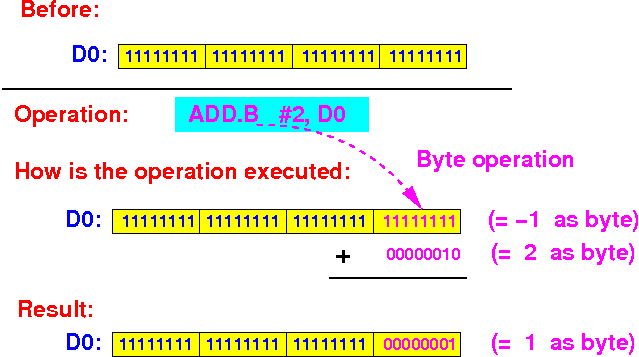
- ADD.W:
adding short (16 bits)
operands
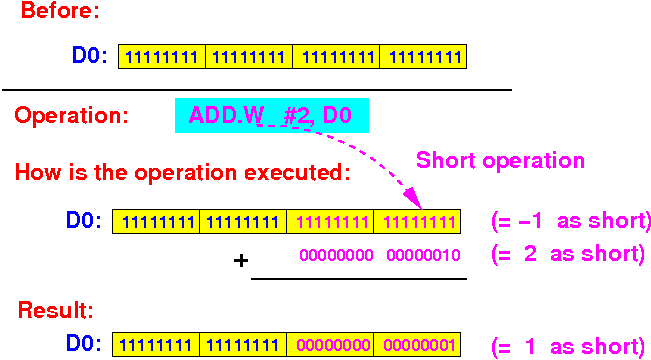
- ADD.L:
adding int (32 bits)
operands
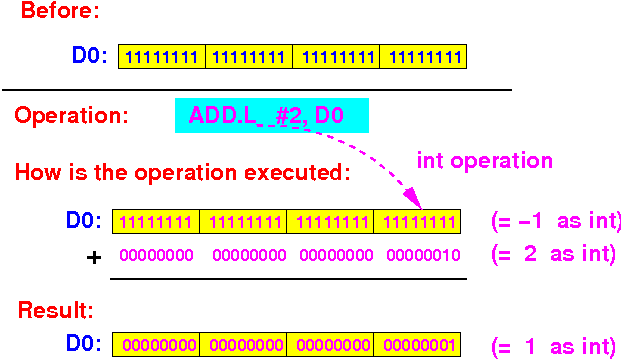
- ADD.B:
adding byte
operands
- Example of ADD
instruction using values in a
data register:
- ADD.B:
adding byte
operands

- ADD.W:
adding short (16 bits)
operands
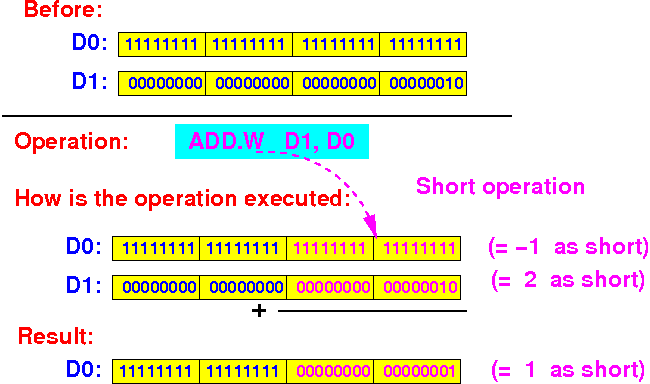
- ADD.L:
adding int (32 bits)
operands
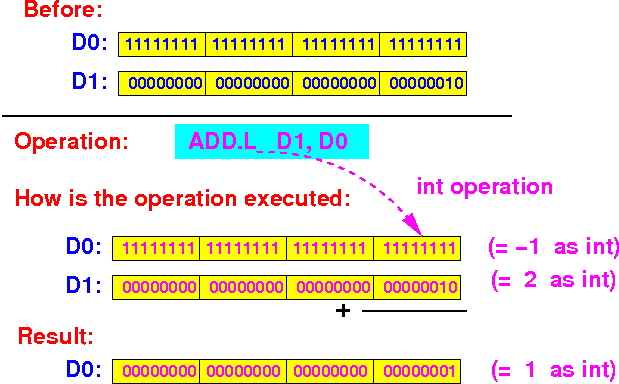
- ADD.B:
adding byte
operands
- Recall how
integer (= whole number)
values are
stored in
(RAM) memory:

- Recall also the
order in which the
bytes are stored:
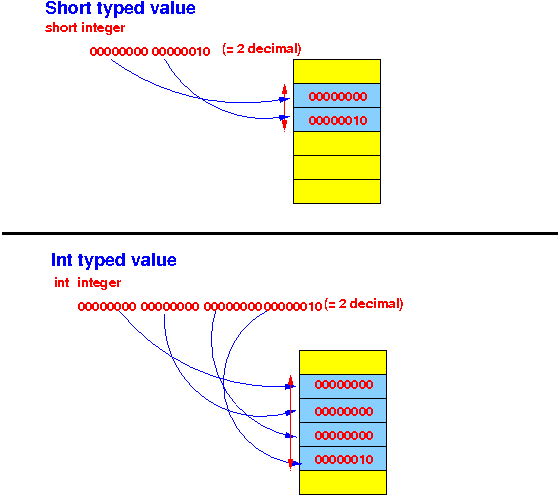
- Example 1:
adding a short typed value
using the different
add instructions
- Suppose we define a
short typed variable
x as follows:
x: dc.w 2 * A short variable containing the value 2
- The memory will contain
the following
short representation:
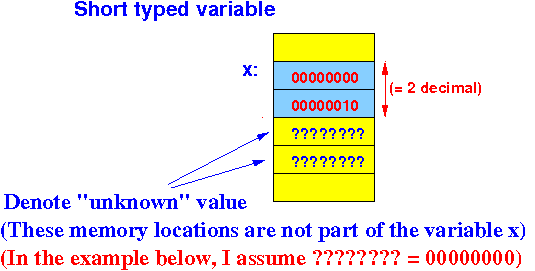
- How ADD.B work on
a short typed
memory variable:
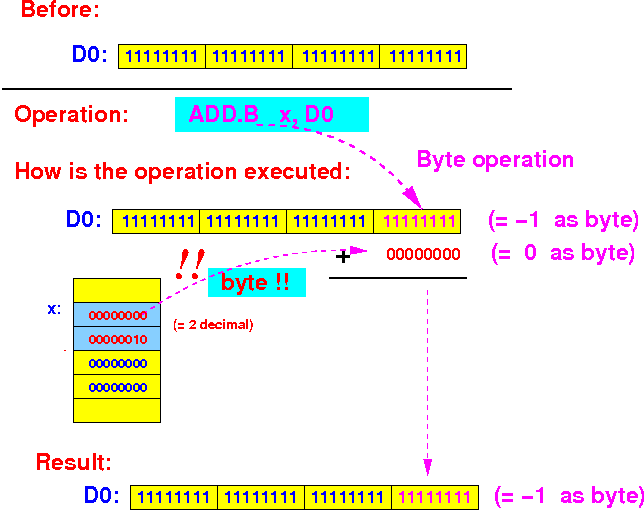
Comment:
- ADD.B used on a
short typed variable
did not perform
correctly !!!
(This is a bug !!!)
- ADD.B used on a
short typed variable
did not perform
correctly !!!
- How ADD.W work on
a short typed
memory variable:
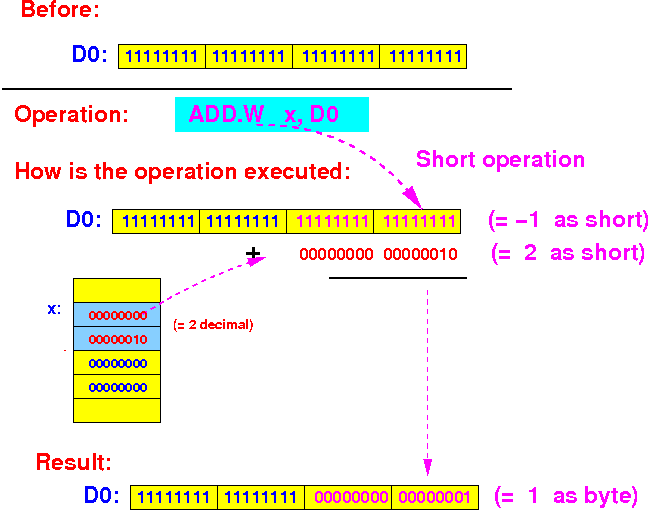
Comment:
- ADD.W used on a
short typed variable
works
correctly !!!
(We added 2 to -1 and obtained 1 as answer --- use only 16 bits in D0 in your interpretation !!!)
- ADD.W used on a
short typed variable
works
correctly !!!
- How ADD.L work on
a short typed
memory variable:
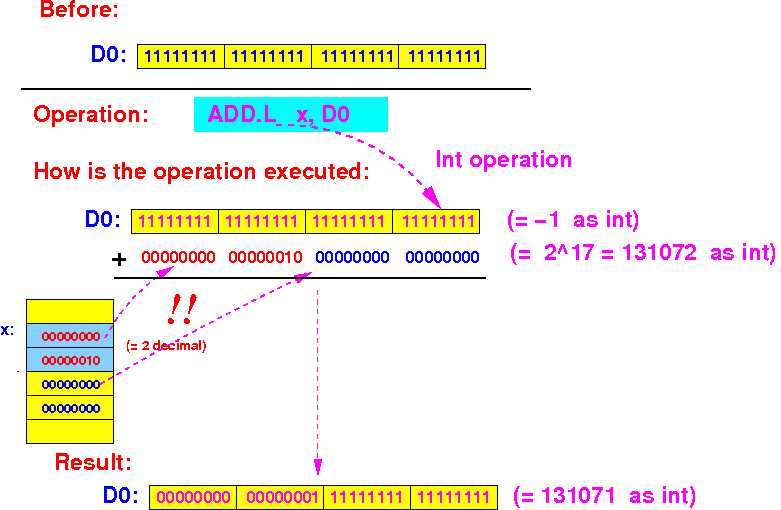
Comment:
- ADD.L used on a
short typed variable
did not perform
correctly !!!
(This is also a bug !!!)
- ADD.L used on a
short typed variable
did not perform
correctly !!!
- Suppose we define a
short typed variable
x as follows:
- Example 2:
adding a int typed value
using the different
add instructions
- Suppose we define a
int typed variable
x as follows:
x: dc.l 2 * A short variable containing the value 2
- The memory will contain
the following
short representation:

- How ADD.B work on
a int typed
memory variable:

Comment:
- ADD.B used on a
int typed variable
did not perform
correctly !!!
(This is a bug !!!)
- ADD.B used on a
int typed variable
did not perform
correctly !!!
- How ADD.W work on
a int typed
memory variable:
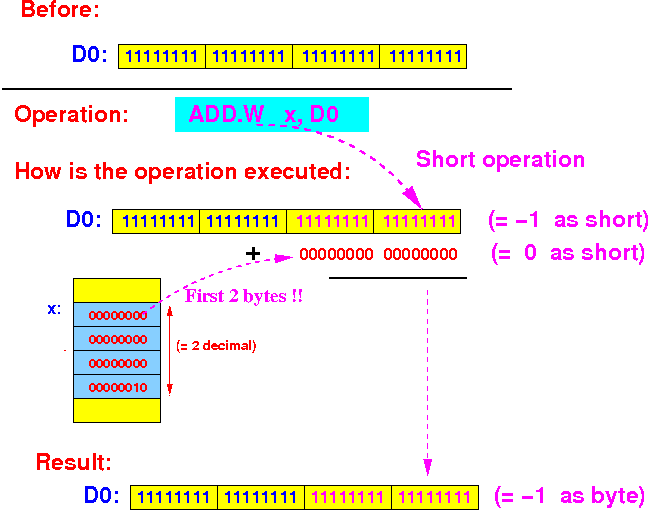
Comment:
- ADD.B used on a
int typed variable
did not perform
correctly !!!
(This is a bug !!!)
- ADD.B used on a
int typed variable
did not perform
correctly !!!
- How ADD.L work on
a int typed
memory variable:
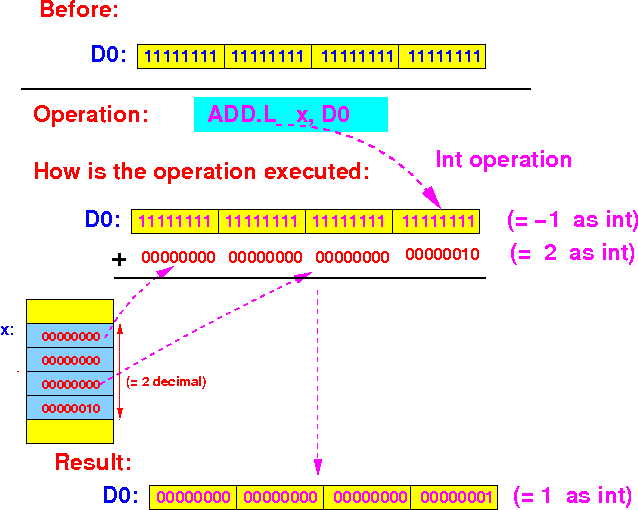
Comment:
- ADD.L used on a
int typed variable
works
correctly !!!
(We added 2 to -1 and obtained 1 as answer --- we must use all 32 bits in D0 in your interpretation !!!)
- ADD.L used on a
int typed variable
works
correctly !!!
- Suppose we define a
int typed variable
x as follows:
- M68000 has
another
ADD instruction
with the following
syntax:
1. ADD.B Dn, Dst // Add the 8 bits 2's complement values in Dn + Dst // and store the 8 bits sum in destination Dst 2. ADD.W Dn, Dst // Add the 16 bits 2's complement values in Dn + Dst // and store the 16 bits sum in destination Dst 3. ADD.L Dn, Dst // Add the 32 bits 2's complement values in Dn + Dst // and store the 32 bits sum in destination Dst
- Comment:
- The ADD Dn, Dst
instruction is
similar to the
ADD Src, Dn instruction
- The difference is the M68000 CPU will store the result in the Dst operand (instead of storing the result in the data register Dn)
- The ADD Dn, Dst
instruction is
similar to the
ADD Src, Dn instruction
- Fact:
- When the destination of the
add instruction is
an address register, the
instruction nmemonic
gets an a appended
to the tail
- When the destination is an address register, you can only use word size and long word size instructions
- When the destination of the
add instruction is
an address register, the
instruction nmemonic
gets an a appended
to the tail
- There are 2 instructions to
add into an
address register:
1. ADDA.W Src, An * Add the 16 bit value Src to the address reg An * I.e.: An = An + Src(16 bits) 2. ADDA.L Sec, An * Add the 32 bit value Src to the address reg An * I.e.: An = An + Src(32 bits)
- How the
ADDA instruction
work:
- Fact:
- An
address in
M68000 is
always a
32 bit binary number
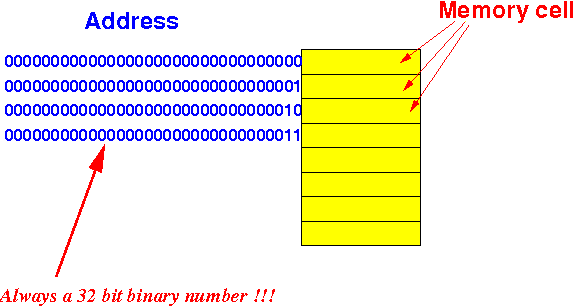
Therefore:
- An operation using an
address register as
destination will:
- Always be performed in 32 bits
- An
address in
M68000 is
always a
32 bit binary number
In other words:
1. ADDA.W Src, An * Add the short (16 bit) Src to the address reg An * I.e.: An = An + Src(16 bits) is executed as follows: Step 1: convert the short (16 bit) Src to an int (32 bits) Step 2: add the (converted) result to address register An
2. ADDA.L Sec, An * Add the int (32 bit) Src to the address reg An * I.e.: An = An + Src(32 bits) (We don't need to perform conversion, because the Src is an int) (We just add the int Src value to the address reg An)
- Fact:
- Example 1:
the execution of
ADDA.W
with a (short) constant
- Suppose the
address register
A0
contains the following:

- ADD.W #2, A0 is
executed as
follows:
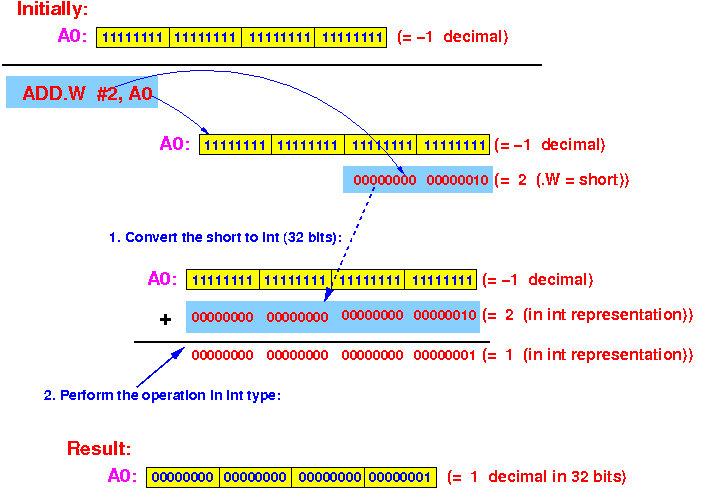
Note:
- Compare this to
the ADD.W #2, D0 operation
using a data register
with the same value
(= 11111111 11111111 11111111 11111111):

Notice that the ADD.W operation produces a short typed (16 bits representation) result
The ADDA.W operation always produces a int typed (32 bits representation) result
- Suppose the
address register
A0
contains the following:
- Example 2:
the execution of
ADDA.W
with a (short) value
in a data register
- Suppose the
registers
A0 and
D1
contains the following:
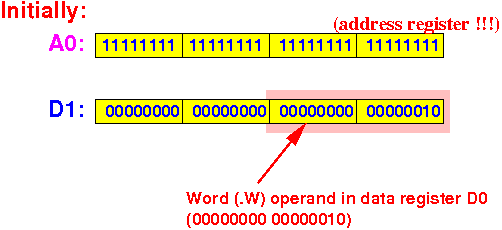
- ADD.W D0, A0 is
executed as
follows:
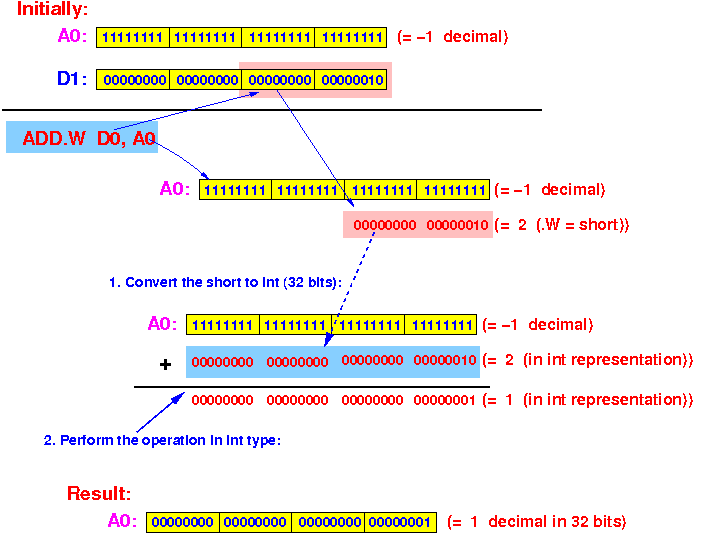
- Suppose the
registers
A0 and
D1
contains the following: